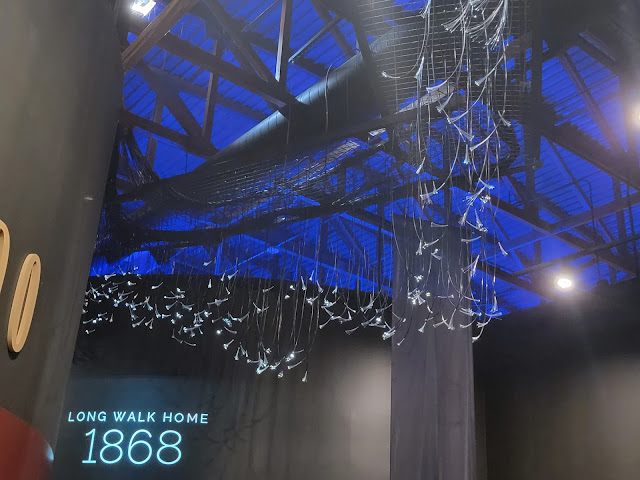A visit to the Bosque Redondo Memorial is an extraordinarily powerful and sobering experience - and highly recommended to anyone interested in the history of North America.
To quote, in part, from the website (www.nmhistoricsites.org/bosque-redondo):
"From 1863 to 1868, Fort Sumner, New Mexico was the
center of a million-acre parcel known as the Bosque Redondo Indian Reservation.
The story of how the U.S. Army used scorched earth policies to forcibly remove
Navajo and Mescalero Apache people from their traditional homelands to this
lonely, inhospitable outpost along the Pecos River is pivotal to the history of
the American West. The Navajo call this the Long Walk, when over 50 different groups
made the 300+ mile journey over a period of nearly three years. Several hundred
Navajo captives either died during the walk or were abducted by slave traders. ...
... For the Mescalero, a
historically migratory people who hunted and gathered freely in the mountains
of the southwest, being rounded up, made sedentary on a single piece of land,
and forced to ‘farm’ was in and of itself a form of cultural genocide.
Confining members of these two completely disparate cultures together and
pitting them against each other was another form of cruelty inflicted upon the
prisoners. ...
...During their internment, the Navajo and Mescalero were
prevented from practicing ceremonies, singing songs, or praying in their own
language. Daily depredations at the reservation were palpable on every level.
Food rationing was both meager and completely foreign (coffee beans, white
flour and rank beef), while the lack of wood for heating and cooking during the
bitterly cold winters led to illness, and high infant mortality. When a
smallpox-like disease was contracted from the military, it ravaged the
captives. The suffering from exposure, starvation, and sickness took an estimated
1500 lives. In 1865 close to 350 Mescalero made their escape and returned to
their sacred Sacramento Mountains. Nearly 1,000 Navajos also fled but more than
7,000 remained. ...
...This dark chapter in our national history finally came to an end in 1868 with the signing of a treaty and the return of Navajo survivors to their traditional homelands. While the treaty established the sovereignty of the Navajo Nation, it also outlined the oppressive conditions under which they would be bound, and forever changed the way they would live. As well, the Mescalero Apache Tribe had a similar experience after they signed a treaty in 1873. The pedagogy of oppression employed throughout the US policies has reshaped their cultures on every level: mentally, politically, and spiritually.
In 2005, the New Mexico State Monuments Division and the Museum of New Mexico, with strong support from Navajo and Mescalero, created the Bosque Redondo Memorial. It stands today to acknowledge the events of the 1860s and to allow those affected by the history to have a voice to tell their history. Designed by Navajo architect David Sloan in the shape of a hogan and a tepee, the museum and an interpretive trail provide an exhibit and educational programs to all who seek it.”
...This dark chapter in our national history finally came to an end in 1868 with the signing of a treaty and the return of Navajo survivors to their traditional homelands. While the treaty established the sovereignty of the Navajo Nation, it also outlined the oppressive conditions under which they would be bound, and forever changed the way they would live. As well, the Mescalero Apache Tribe had a similar experience after they signed a treaty in 1873. The pedagogy of oppression employed throughout the US policies has reshaped their cultures on every level: mentally, politically, and spiritually.
In 2005, the New Mexico State Monuments Division and the Museum of New Mexico, with strong support from Navajo and Mescalero, created the Bosque Redondo Memorial. It stands today to acknowledge the events of the 1860s and to allow those affected by the history to have a voice to tell their history. Designed by Navajo architect David Sloan in the shape of a hogan and a tepee, the museum and an interpretive trail provide an exhibit and educational programs to all who seek it.”




No comments:
Post a Comment